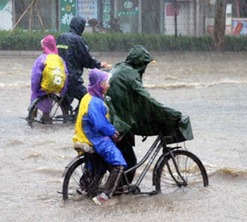Intense rainfalls are getting bigger and more frequent, causing local governments, engineers and landowners to rethink whether sewer systems and other drainage features are up to their tasks. The storm water filtration pond near Cedar Lake in Minneapolis, for instance, needed to be cleaned out six years after it was built, instead of the 25 years designers expected. Researchers point directly at a warming climate as the cause. Warmer air holds more water vapor, and a longer storm season means intense storms can occur more frequently in what once were regarded as the off-seasons. As more northerly latitudes have warmed, the storm-producing clashes between warm and cold air masses have moved northward as well,  a key reason why the Upper Midwest has seen a steep increase in extreme precipitation. The Upper Midwest saw a 31 percent increase in "intense" rainfalls (the statistical 1 percent events) from 1958 to 2007, over previous decades, according to the National Climactic Data Center. That was the second-highest increase among eight U.S. regions, including Alaska and Hawaii. New England and the Northeast saw a 67 percent increase. Overall, intense doses of precipitation have become more frequent and more intense in recent decades than at any other time in the historical record and account for a larger percentage of total precipitation, according to a study by the U.S. Climate Change Science Program. Meanwhile, recent weather in Minnesota is hinting that a drought that has persisted for about seven months across much of the state (longer in the Arrowhead) might be loosening its grip. But those kinds of variations don't mean the longer-term trends of increases in intense rainfall might also reverse quickly; excessive rain has been overpowering drought trends in recent decades. At the same time, the classic climate warming scenario dictates that both excess rain and drought are likely simultaneously, as heat evaporates moisture from the land, then dumps it elsewhere in spotty, unpredictable, summer-storm patterns.
a key reason why the Upper Midwest has seen a steep increase in extreme precipitation. The Upper Midwest saw a 31 percent increase in "intense" rainfalls (the statistical 1 percent events) from 1958 to 2007, over previous decades, according to the National Climactic Data Center. That was the second-highest increase among eight U.S. regions, including Alaska and Hawaii. New England and the Northeast saw a 67 percent increase. Overall, intense doses of precipitation have become more frequent and more intense in recent decades than at any other time in the historical record and account for a larger percentage of total precipitation, according to a study by the U.S. Climate Change Science Program. Meanwhile, recent weather in Minnesota is hinting that a drought that has persisted for about seven months across much of the state (longer in the Arrowhead) might be loosening its grip. But those kinds of variations don't mean the longer-term trends of increases in intense rainfall might also reverse quickly; excessive rain has been overpowering drought trends in recent decades. At the same time, the classic climate warming scenario dictates that both excess rain and drought are likely simultaneously, as heat evaporates moisture from the land, then dumps it elsewhere in spotty, unpredictable, summer-storm patterns.
March 24, 2012
Subscribe to:
Post Comments (Atom)


No comments:
Post a Comment